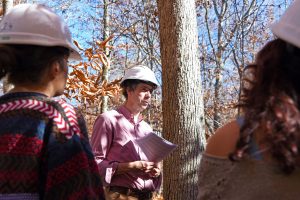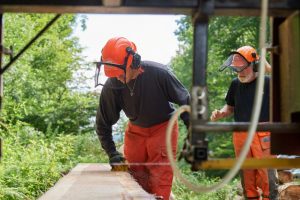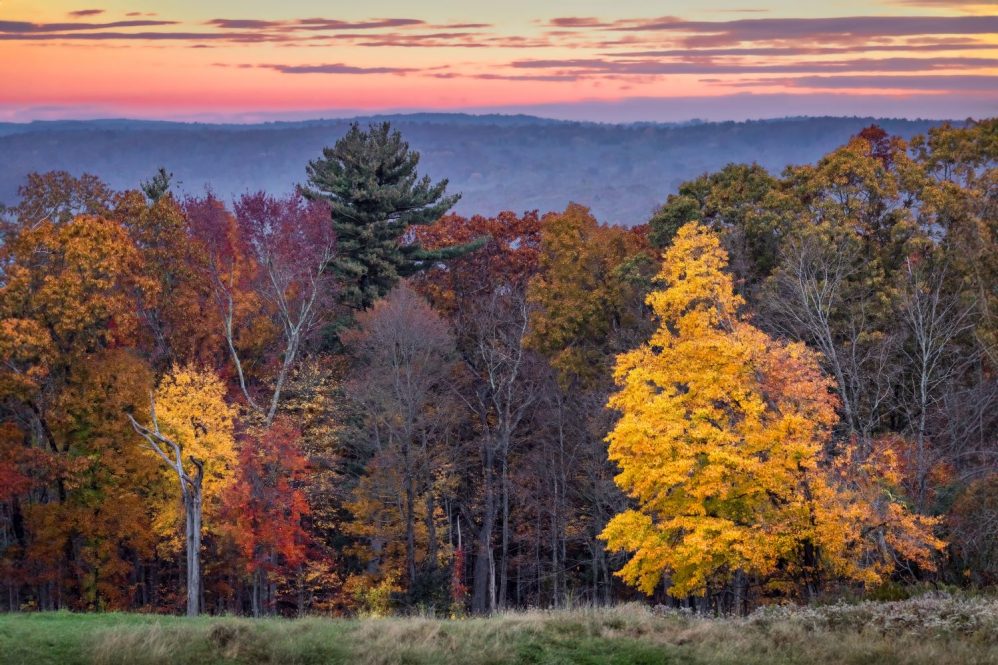The UConn Forest is a key feature of the UConn Storrs campus. Aside from being a beautiful place to appreciate Connecticut’s nature, the Forest is a site for research, education, and extension work.
Robert Fahey, George F. Cloutier Professor in Forestry in the Department of Natural Resources and the Environment (NRE), is engaged in multiple research projects in the Forest with the goal of understanding what makes the ecosystems more resilient in the face of adverse weather, pestilence, and other disturbances.
“Our ability to have the UConn Forest as a living research lab steps away is super important and very convenient. You won’t find this sort of set up on most university campuses,” Fahey says.

With one project, Fahey is studying the canopy of the UConn Forest. Using 3D computer modelling, Fahey and his team are working to understand how the structure of the canopy affects carbon dynamics – how much carbon dioxide the trees absorb, sequester, and release – and how the canopy responds to disturbances.
This novel approach allows the researchers to simulate disturbances, like storms, to see their impact on the canopy overall.
“We can remove individual trees from that model in the canopy to see what different removal patterns would do to the canopy,” Fahey says.
Beyond the computer model, Fahey’s team is cutting down trees in the Forest to simulate a windstorm or other disturbance. They will monitor these sites for at least 10 years in order to determine the long-term impact on the canopy. The researchers will also use computer modelling to simulate the impact 100 years into the future.
Fahey is also working with James Knighton, assistant professor of NRE, on the effects of specific tree species on ecosystem functioning.
This work is inspired by the historical loss of tree species in the region, such as American chestnut trees in the early 20th century, as well as recent introductions such as the emerald ash borer, which has killed hundreds of millions of ash trees nationwide.
“We need a better understanding of what the loss of these trees will do,” Fahey says.
The UConn Forest is also a key education resource. There are dozens of classes around campus that use the Forest. Thomas Worthley, associate extension professor of forest stewardship, has used the UConn Forest as part of his classes for the past 15 years.
Worthley teaches classes on dendrology (tree identification) and forest management.
The UConn Forest is an ideal learning environment for students who want to work in the northeast as it is typical of forests in this region, Worthley says.
By engaging the students in hands-on projects, Worthley can teach them not only the skills they need to identify problems and develop solutions, but the manual skills they will need on the job to operate equipment safely.
In his dendrology class, Worthley takes students to the Forest so they can learn to identify trees in their natural habitats. With his forest management students, Worthley engages them in hands-on projects where they make management decisions and design silvicultural “prescriptions” for different areas of the forest.
For example, the woodcock, a ground-nesting bird in Connecticut, is susceptible to habitat loss. The woodcock needs very dense, short vegetation – which is in short supply in the region, where mature forests are more common.
A prescription to increase woodcock nesting habitat could involve removing some larger trees to make room for saplings. Worthley and his class have established a site like this along Discovery Drive.

At right is Thomas Worthley, associate extension professor of forest stewardship. (Peter Morenus/UConn Photo)
“It’s almost impenetrable to human beings, but ideal habitat for ground-nesting birds,” Worthley says.
At the top of Horsebarn Hill Road, a stand of ash trees was dying from an emerald ash borer infestation. In 2013, Worthley and his students, anticipating the danger the pest posed to the trees, thinned the stand out, allowing the strongest trees to grow for as long as they could. In 2022, they salvaged them.
“The question was ‘Do you leave everything alone and look at a stand of dead trees and an understory of invasive shrubs for the next 20 years, or do you create a big disturbance and start things all over again?’” Worthley says. “And we opted for the second scenario.”
Worthley and his students are now planting native plants, like sugar maples, in the area, providing habitat for birds.
UConn students aren’t the only ones benefitting from the UConn Forest and Worthley’s knowledge. The unique space is an important tool for UConn Extension’s engagement with Connecticut’s communities. Through his Extension work, Worthley regularly leads tours of research sites in the Forest for the public where they can learn about forest management. Worthley also engages in outreach to woodland owners and professionals so they can learn about and adopt these evidence-based techniques.
“We have done both things at [these sites] to advance and share some of the work that we’ve done and what we’ve achieved with other folks,” Worthley says.
Worthley emphasizes the value of the UConn Forest lies in its great diversity as a space of recreation, education, research, and community outreach.
“It’s a great example of the uses of forest land in our region in terms of their multiple benefits – habitat, recreation, wood products, watershed protection – we try to enhance, maintain, and protect all of these things,” Worthley says. “And they’re happening all at once on the same property. It makes for a very interesting asset to be able to share with students and get them involved.”
This work relates to CAHNR’s Strategic Vision area focused on Fostering Sustainable Landscapes at the Urban-Rural Interface.
Follow UConn CAHNR on social media



